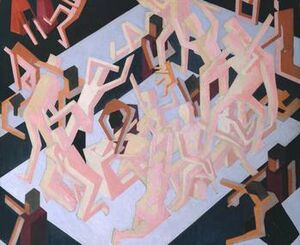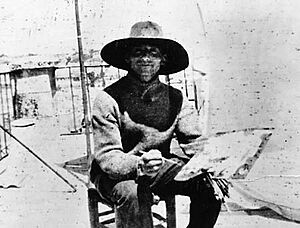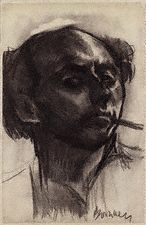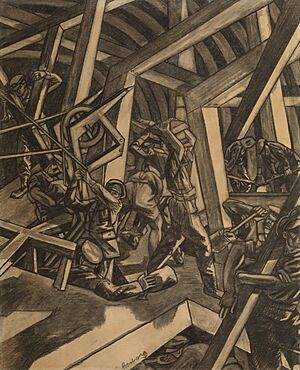David Bomberg facts for kids
Quick facts for kids
David Bomberg
|
|
|---|---|

Photograph of David Bomberg, c.1925.
|
|
| Born |
David Bomberg
5 December 1890 Birmingham, England
|
| Died | 19 August 1957 (aged 66) London, England
|
| Education |
|
| Known for | Painting, drawing, teaching |
| Movement | Vorticism, Cubism, Futurism |
David Garshen Bomberg (born December 5, 1890 – died August 19, 1957) was an important British painter. He was known for his bold and unique art style. David Bomberg was part of a group called the Whitechapel Boys.
He was one of the most daring artists who studied at the famous Slade School of Art. His teachers included Henry Tonks. Other famous students there were Mark Gertler and Stanley Spencer. Before World War I, Bomberg created amazing geometric paintings. These artworks mixed ideas from cubism and futurism. He often used bright colors and turned people into simple, sharp shapes. Sometimes, he added a strong grid pattern over his paintings.
In 1913, David Bomberg was asked to leave the Slade School. This happened because his art was too different from the traditional styles taught at the time. After his experiences in World War I, Bomberg's art changed. In the 1920s, he started painting more realistic pictures. He focused on portraits and landscapes. He traveled a lot, painting scenes from the Middle East and Europe. His style slowly became more expressionist, showing strong feelings.
From 1945 to 1953, Bomberg taught art at Borough Polytechnic in London. Many of his students became famous artists themselves. These included Frank Auerbach and Leon Kossoff. A student building at London South Bank University is named David Bomberg House in his honor. He was married to another artist, Lilian Holt.
Contents
Early Life and Art Training
David Bomberg was born in Birmingham, England, on December 5, 1890. He was the seventh of eleven children. His family was Polish Jewish immigrants. His mother, Rebecca, supported his dream of becoming a painter. In 1895, his family moved to Whitechapel in East End of London. He spent the rest of his childhood there.
After studying art at City and Guilds, Bomberg went back to Birmingham. He trained to be a lithographer. But he soon left to study art under Walter Sickert. This was at Westminster School of Art from 1908 to 1910. Sickert taught him to focus on shapes and real-life scenes. This was a big influence on Bomberg. He also saw the work of Paul Cézanne at an exhibition in 1910.
Becoming an artist was hard for Bomberg financially. But in 1911, he got help from John Singer Sargent. He also received support from the Jewish Education Aid Society. This allowed him to get a spot at the Slade School of Art.
Studying at the Slade School

At the Slade School of Fine Art, Bomberg was part of a special group of artists. Their drawing teacher, Henry Tonks, called them a "crisis of brilliance." This group included Stanley Spencer, Paul Nash, and Mark Gertler. Bomberg became close friends with Isaac Rosenberg, who came from a similar background.
The Slade School focused on strong drawing skills. Bomberg was good at this. He even won a prize for his drawing of Isaac Rosenberg in 1911. However, his own art style quickly moved away from these old ways. He was greatly influenced by a London exhibition in 1912. It showed art by Italian Futurists like Francis Picabia. He also saw works by Pablo Picasso and Henri Matisse at another exhibition.
Bomberg's new style was clear in paintings like Vision of Ezekiel (1912). This painting showed he could take new European ideas and mix them with Jewish influences. He created something strong and new. His art used sharp, angular shapes for people. It combined the geometric style of cubism with the energy of the Futurists. This made him known as a bold artist. In 1913, he was expelled from the Slade School because his art was so radical. That same year, he traveled to France with Jacob Epstein. There, he met other famous artists like Amedeo Modigliani and Pablo Picasso.
Before World War I: The Avant-Garde Scene

After leaving the Slade in 1913, Bomberg worked with different art groups. He briefly joined the Bloomsbury Group's Omega Workshops. Then he showed his art with the Camden Town Group in December 1913. He loved the energy of machines and modern life. This connected him to Wyndham Lewis's new vorticist movement. Five of his paintings were in the first exhibition of the London Group in 1914.
Bomberg was very independent. Even though Lewis tried, Bomberg never officially joined Vorticism. He refused to be part of their magazine, BLAST, in 1914. His work was only shown as an "Invited to show" artist at a vorticist exhibition in 1915.
The year 1914 was a high point for his early career. He had his own art show at the Chenil Gallery in Chelsea. Art critics like Roger Fry praised his work. The show featured some of his best early paintings, like The Mud Bath (1914). This painting was so striking that it was hung outside the gallery.
Bomberg explained his art in the exhibition catalog: "I look upon Nature while I live in a steel city... My object is the construction of Pure Form. I reject everything in painting that is not Pure Form." With help from Augustus John, Bomberg sold two paintings from this show to a famous American collector, John Quinn.
World War I and Later Art

Even with his successful exhibition, Bomberg still faced money problems. In 1915, he joined the Royal Engineers. He later moved to the King's Royal Rifle Corps. In March 1916, he was sent to the Western Front.
World War I deeply changed Bomberg's view of the world. The horrors of war and the death of his brother destroyed his belief in modern machines. This change is clear in his painting Sappers at Work (1918–1919). He was asked to paint it for the Canadian War Memorials Fund. His first version was rejected. He then painted a second, much more realistic version.
After the war, Bomberg started to explore new ways of painting. He wanted his art to be more natural and flowing. From 1923 to 1927, he traveled to Palestine to paint and draw. He mixed the geometric style of his early work with the traditional English landscape painting. He was inspired by artists like Turner and Constable.
Later Years and Teaching

After Palestine, Bomberg painted many landscapes in Spain. He also painted in Cyprus and different parts of Britain, especially Cornwall. During World War II, he painted Evening in the City of London (1944). This painting showed London after the bombings, with St Paul's Cathedral still standing tall. It is seen as one of the most touching paintings of wartime Britain. He also painted a series of "Bomb Store" paintings (1942). These showed his feelings about the destructive power of modern war.
Bomberg was also a fantastic drawer of portraits. He drew many throughout his life. From his early "Head of a Poet" (1913) of his friend Isaac Rosenberg, to his "Last Self-Portrait" (1956).
After World War II, Bomberg could not get a teaching job at the major London art schools. But he became a very important teacher at the Borough Polytechnic. He taught part-time in a bakery school. Even though his students did not get grants or diplomas, they were very dedicated. He exhibited his work alongside his students in groups like the Borough Group (1946–51). He developed a deep philosophy about art, which he called "The Spirit in the Mass."
David Bomberg died in London in 1957. His art became much more recognized after his death. He had lived for many years on the earnings of his second wife, Lilian Holt. He died in poverty, but his artistic legacy grew stronger.
Images for kids




